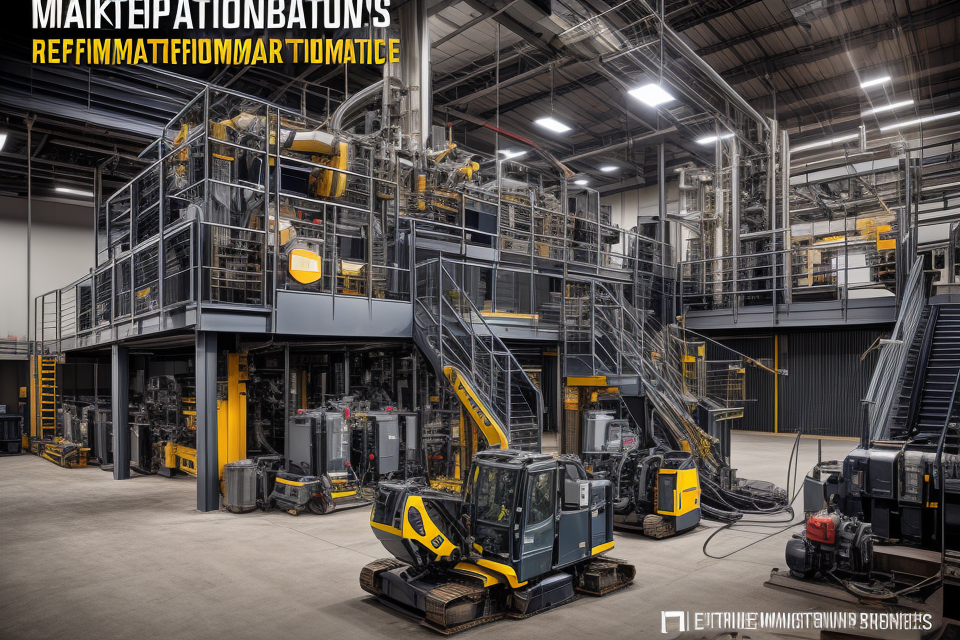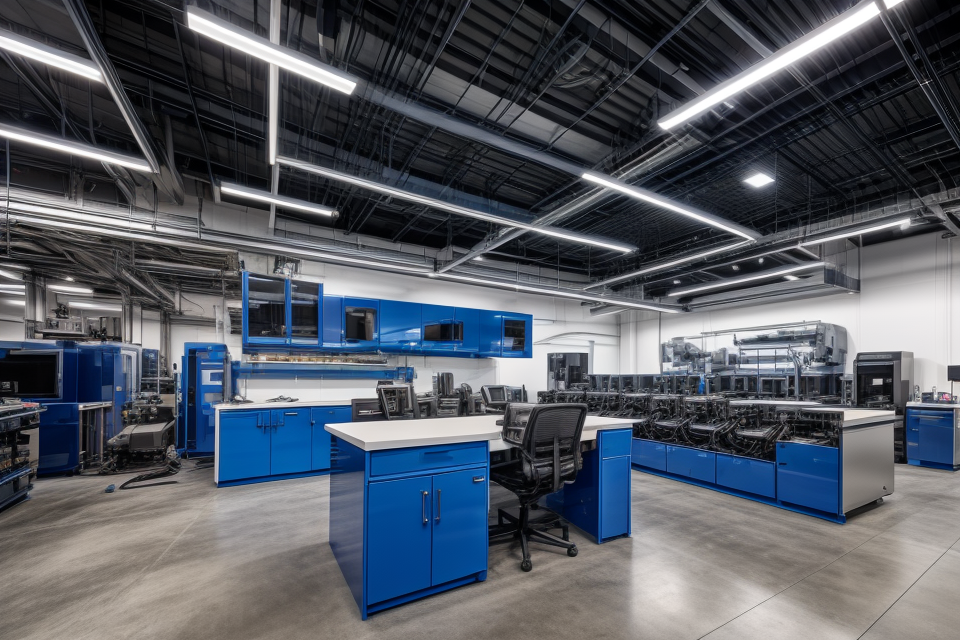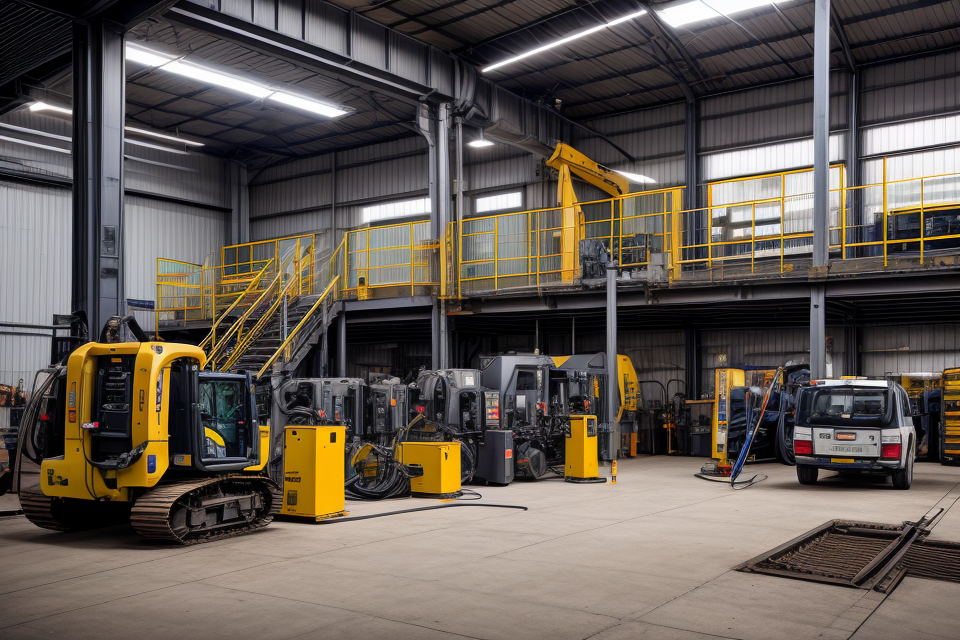Maintaining equipment is crucial for ensuring its longevity and efficiency. But with so many types of maintenance available, it can be challenging to determine which one is the best for your equipment. This article will explore the different types of maintenance and help you determine which one is right for your needs. Whether you’re dealing with routine upkeep or emergency repairs, we’ll provide you with the information you need to make informed decisions that will keep your equipment running smoothly. So, let’s dive in and uncover the best type of maintenance for optimal equipment performance.
Understanding Equipment Maintenance
Importance of Equipment Maintenance
Proper equipment maintenance is crucial for ensuring optimal performance and longevity of equipment. It can have a significant impact on the bottom line of a business by reducing downtime and repair costs. Additionally, regular maintenance can help ensure that equipment is safe and compliant with industry regulations.
- Prolonging equipment lifespan: Regular maintenance can help prevent equipment breakdowns and prolong the lifespan of equipment. This is because routine maintenance helps to identify and address potential issues before they become serious problems. By identifying and addressing potential issues early on, businesses can avoid costly repairs and replacements that can be caused by equipment failure.
- Reducing downtime and repair costs: Equipment downtime can be costly for businesses, as it can lead to lost productivity and revenue. Regular maintenance can help reduce downtime by identifying and addressing potential issues before they cause equipment failure. Additionally, routine maintenance can help prevent unexpected repairs, which can be costly and disruptive to business operations.
- Ensuring safety and compliance: Regular maintenance is also important for ensuring that equipment is safe and compliant with industry regulations. For example, regular inspections and testing can help identify potential safety hazards and ensure that equipment is operating within safe parameters. Additionally, regular maintenance can help ensure that equipment is in compliance with industry regulations, which can help avoid costly fines and penalties.
Types of Maintenance
There are three main types of maintenance that are commonly used to ensure optimal equipment performance: preventive maintenance, corrective maintenance, and predictive maintenance.
- Preventive maintenance is a type of maintenance that is performed regularly to prevent equipment failures or breakdowns. This type of maintenance involves performing routine inspections, cleaning, and replacement of worn parts before they cause problems. The goal of preventive maintenance is to prevent equipment failures and extend the lifespan of the equipment.
- Corrective maintenance is a type of maintenance that is performed after an equipment failure or breakdown. This type of maintenance involves identifying the cause of the failure and repairing or replacing the affected parts. The goal of corrective maintenance is to restore the equipment to its normal operating condition as quickly as possible.
- Predictive maintenance is a type of maintenance that uses data and analytics to predict when equipment is likely to fail. This type of maintenance involves monitoring equipment performance, analyzing data, and using predictive models to identify potential equipment failures before they occur. The goal of predictive maintenance is to prevent equipment failures and reduce downtime by scheduling maintenance at the most appropriate times.
In conclusion, understanding the different types of maintenance is crucial for choosing the best type of maintenance for optimal equipment performance. Preventive maintenance, corrective maintenance, and predictive maintenance each have their own advantages and disadvantages, and the best type of maintenance will depend on the specific equipment and its operating conditions.
Identifying the Best Type of Maintenance
Factors to Consider
Equipment type and usage:
One of the most critical factors to consider when determining the best type of maintenance for equipment is the equipment type and usage. Different types of equipment require different maintenance approaches, and it is essential to choose the right one for the specific equipment. For instance, equipment that operates in harsh environments, such as manufacturing plants or construction sites, requires more frequent and rigorous maintenance than equipment used in a controlled environment, such as office equipment.
Maintenance history and frequency:
Another factor to consider is the maintenance history and frequency of the equipment. Equipment that has been well-maintained in the past may require less maintenance in the future, while equipment that has not been well-maintained may require more frequent maintenance to keep it in optimal condition. Regular maintenance, such as cleaning and lubrication, can help prevent equipment breakdowns and extend the equipment’s lifespan.
Resource availability and cost:
The availability and cost of resources, such as personnel, tools, and replacement parts, are also essential factors to consider when determining the best type of maintenance for equipment. Maintenance that requires specialized skills or expensive tools may not be feasible for some organizations, while others may have the resources to implement more rigorous maintenance programs. It is important to weigh the cost of maintenance against the potential benefits of keeping equipment in optimal condition.
Overall, identifying the best type of maintenance for equipment requires a thorough understanding of the equipment type and usage, maintenance history and frequency, and resource availability and cost. By considering these factors, organizations can develop a maintenance program that maximizes equipment performance and minimizes downtime.
Preventive Maintenance
Preventive maintenance is a type of maintenance strategy that involves performing routine tasks on equipment to prevent breakdowns and prolong its lifespan. This approach is highly effective in ensuring that equipment remains in optimal condition and operates efficiently throughout its lifecycle.
Definition and Benefits
Preventive maintenance is a proactive approach to equipment maintenance that aims to identify and address potential issues before they become serious problems. This type of maintenance is focused on maintaining equipment in good working order by performing regular inspections, cleaning, lubrication, and repairs.
The benefits of preventive maintenance are numerous. It can help reduce downtime, extend the lifespan of equipment, improve efficiency, and lower maintenance costs. By performing regular maintenance tasks, equipment can operate at peak performance, reducing the risk of unexpected breakdowns and repairs.
Examples of Preventive Maintenance Tasks
There are various preventive maintenance tasks that can be performed on equipment, depending on the type of equipment and its specific needs. Some common examples of preventive maintenance tasks include:
- Cleaning and inspecting equipment
- Lubricating moving parts
- Replacing filters and other components
- Inspecting electrical connections and wiring
- Testing and calibrating sensors and controls
Scheduling and Implementing Preventive Maintenance
To ensure that preventive maintenance is effective, it is important to establish a schedule for performing routine tasks. This can involve developing a maintenance plan that outlines the frequency and scope of maintenance tasks, as well as identifying the personnel responsible for performing them.
Implementing preventive maintenance requires a proactive approach to equipment maintenance. This involves regularly inspecting equipment, identifying potential issues, and addressing them before they become serious problems. It also involves maintaining accurate records of maintenance activities, including when tasks were performed, what was done, and any issues that were identified.
Overall, preventive maintenance is a highly effective approach to equipment maintenance that can help ensure that equipment operates at peak performance and prolong its lifespan. By establishing a regular maintenance schedule and performing routine tasks, equipment can be maintained in good working order, reducing the risk of unexpected breakdowns and downtime.
Corrective Maintenance
Corrective maintenance refers to the process of repairing or replacing equipment components after they have failed or broken down. This type of maintenance is typically reactive, meaning that it is performed in response to a problem or issue that has already occurred.
Benefits of Corrective Maintenance:
- Can help to prevent further damage or downtime
- Can extend the lifespan of equipment
- Can reduce the need for costly replacements or repairs
Examples of Corrective Maintenance Tasks:
- Replacing faulty components
- Repairing damaged equipment
- Addressing leaks or other fluid losses
- Replacing worn or damaged parts
Detecting and Addressing Equipment Failures:
- Regular inspections and testing
- Implementing condition-based monitoring systems
- Conducting root cause analysis after equipment failures
- Developing and implementing preventative maintenance strategies to address potential issues before they lead to failures.
Predictive Maintenance
Definition and Benefits
Predictive maintenance is a proactive approach to equipment maintenance that uses data and advanced analytics to predict when equipment is likely to fail. It is designed to optimize equipment performance by identifying potential problems before they occur, allowing businesses to schedule maintenance at the most convenient and cost-effective times.
Predictive maintenance offers several benefits over traditional reactive maintenance, including:
- Reduced downtime: By identifying potential problems before they cause equipment failure, predictive maintenance can significantly reduce downtime and lost productivity.
- Cost savings: Predictive maintenance can help businesses save money by reducing the need for unplanned repairs and replacing equipment less frequently.
- Improved equipment reliability: By ensuring that equipment is properly maintained, predictive maintenance can help businesses achieve better performance and longer lifespans for their equipment.
Examples of Predictive Maintenance Techniques
There are several techniques used in predictive maintenance, including:
- Condition monitoring: This involves using sensors and other monitoring devices to collect data on equipment performance and identify potential problems.
- Data analysis: Predictive maintenance relies heavily on data analysis, using algorithms and machine learning models to identify patterns and predict equipment failure.
- Predictive modeling: This involves creating mathematical models that simulate equipment performance and predict when equipment is likely to fail.
Condition Monitoring and Data Analysis
Condition monitoring is a key component of predictive maintenance, as it allows businesses to collect data on equipment performance and identify potential problems before they cause equipment failure. This can involve using sensors and other monitoring devices to collect data on equipment temperature, vibration, and other parameters.
Data analysis is also critical to predictive maintenance, as it allows businesses to analyze the data collected from condition monitoring and identify patterns that can predict equipment failure. This can involve using advanced analytics tools and machine learning algorithms to identify potential problems and predict when equipment is likely to fail.
Overall, predictive maintenance is a powerful tool for optimizing equipment performance and reducing downtime. By using data and advanced analytics to predict when equipment is likely to fail, businesses can schedule maintenance at the most convenient and cost-effective times, helping to improve equipment reliability and reduce costs.
Optimizing Maintenance Strategies
Combining Maintenance Types
In today’s competitive business environment, it is essential to maximize equipment performance while minimizing downtime and maintenance costs. One approach to achieving this goal is by combining different types of maintenance strategies to create a hybrid approach that addresses the unique needs of each piece of equipment.
In this section, we will explore the concept of combining maintenance types to optimize equipment performance.
Combining Maintenance Types
Combining maintenance types involves integrating different approaches to maintenance in order to create a more effective and efficient maintenance program. The three primary maintenance types are preventive, corrective, and predictive maintenance.
Preventive maintenance is a proactive approach to maintenance that involves regularly scheduled inspections and maintenance tasks designed to prevent equipment failures. This type of maintenance is often performed at regular intervals based on time or usage.
Corrective maintenance is a reactive approach to maintenance that involves repairing or replacing equipment components after they have failed. This type of maintenance is typically more expensive than preventive maintenance because it involves downtime and emergency repairs.
Predictive maintenance is a proactive approach to maintenance that involves using data and analytics to predict when equipment is likely to fail. This type of maintenance involves monitoring equipment performance and using that data to identify potential problems before they become serious.
Hybrid Maintenance Strategies
Combining preventive, corrective, and predictive maintenance strategies can help organizations achieve optimal equipment performance while minimizing downtime and maintenance costs. A hybrid maintenance strategy can take many forms, but it typically involves a combination of proactive and reactive maintenance approaches.
One example of a hybrid maintenance strategy is a condition-based maintenance approach. This approach involves monitoring equipment performance and adjusting maintenance schedules based on the condition of the equipment. For example, if equipment is operating well, maintenance tasks may be postponed, while if equipment is showing signs of wear or failure, maintenance tasks may be performed more frequently.
Another example of a hybrid maintenance strategy is a combination of preventive and predictive maintenance. This approach involves using data and analytics to identify potential problems before they become serious, while also performing regular scheduled maintenance tasks to prevent equipment failures.
Balancing Maintenance Types
In order to optimize equipment performance, it is important to balance the different types of maintenance strategies. For example, if an organization relies too heavily on corrective maintenance, it may experience a lot of downtime and high maintenance costs. On the other hand, if an organization relies too heavily on preventive maintenance, it may be wasting resources on unnecessary maintenance tasks.
Balancing maintenance types requires a thorough understanding of the unique needs of each piece of equipment. It also requires a commitment to ongoing monitoring and evaluation to ensure that the maintenance program is meeting the needs of the organization.
In conclusion, combining maintenance types can help organizations achieve optimal equipment performance while minimizing downtime and maintenance costs. By combining preventive, corrective, and predictive maintenance strategies, organizations can create a more effective and efficient maintenance program that meets the unique needs of each piece of equipment.
Implementing Effective Maintenance Programs
Implementing effective maintenance programs is a critical component of optimizing equipment performance. This involves establishing a maintenance management system, providing training and resources for maintenance personnel, and continuously improving and evaluating the program.
Establishing a Maintenance Management System
Establishing a maintenance management system is the first step in implementing effective maintenance programs. This system should include procedures for scheduling maintenance, tracking equipment performance, and managing maintenance personnel. Additionally, it should include a system for documenting and tracking maintenance activities, such as work orders and PM schedules.
Training and Resources for Maintenance Personnel
Providing training and resources for maintenance personnel is essential for implementing effective maintenance programs. This includes providing access to technical information and resources, such as repair manuals and training videos. Additionally, it includes providing ongoing training and development opportunities to ensure that maintenance personnel are up-to-date on the latest technologies and techniques.
Continuous Improvement and Evaluation
Continuous improvement and evaluation is crucial for optimizing maintenance programs. This involves regularly reviewing maintenance data and performance metrics to identify areas for improvement. Additionally, it includes implementing changes to the maintenance program based on this data and continuously evaluating the effectiveness of these changes. By continuously improving and evaluating the maintenance program, organizations can ensure that they are getting the most out of their equipment and maximizing performance.
FAQs
1. What is the best type of maintenance for optimal equipment performance?
The best type of maintenance for optimal equipment performance depends on the specific equipment and its usage. However, preventive maintenance is generally considered the most effective type of maintenance as it involves regularly scheduled inspections and maintenance tasks to prevent equipment failures and breakdowns.
2. What are the benefits of preventive maintenance?
The benefits of preventive maintenance include increased equipment lifespan, reduced downtime and maintenance costs, improved equipment performance, and increased safety. By regularly maintaining equipment, you can catch and address potential issues before they become major problems, reducing the likelihood of unexpected breakdowns and costly repairs.
3. How often should preventive maintenance be performed?
The frequency of preventive maintenance depends on the specific equipment and its usage. However, it is generally recommended to perform preventive maintenance on a regular schedule, such as monthly or quarterly, to ensure that equipment is always in good working condition.
4. What are some common preventive maintenance tasks?
Common preventive maintenance tasks include cleaning and inspecting equipment, lubricating moving parts, replacing filters and belts, and checking and adjusting fluid levels. These tasks can help to identify and address potential issues before they become serious problems.
5. Are there any risks associated with preventive maintenance?
There are minimal risks associated with preventive maintenance, as long as the maintenance is performed properly and safely. However, there is a risk of damage to equipment if maintenance is not performed correctly or if the wrong parts are used. It is important to follow manufacturer guidelines and to use appropriate tools and parts when performing maintenance.










